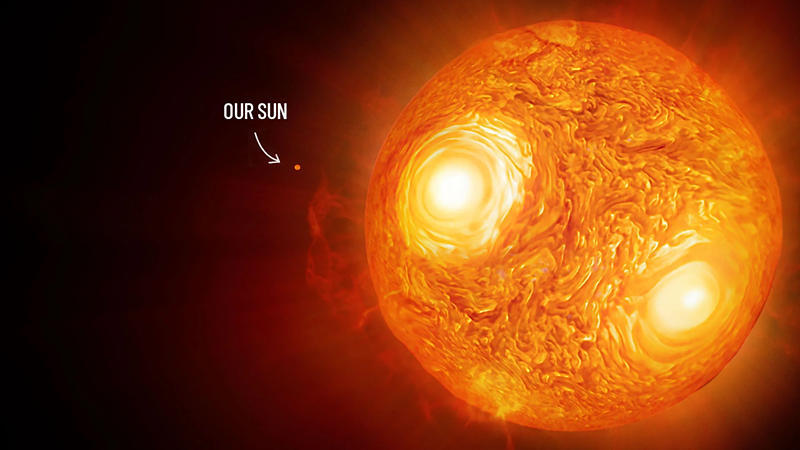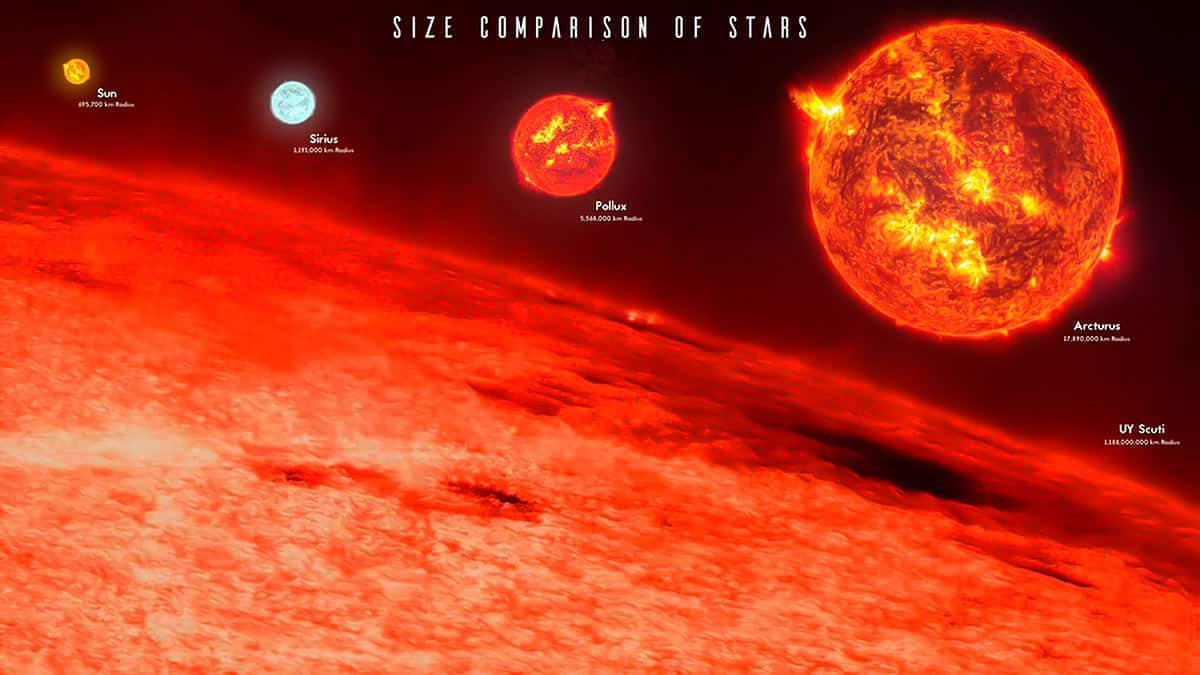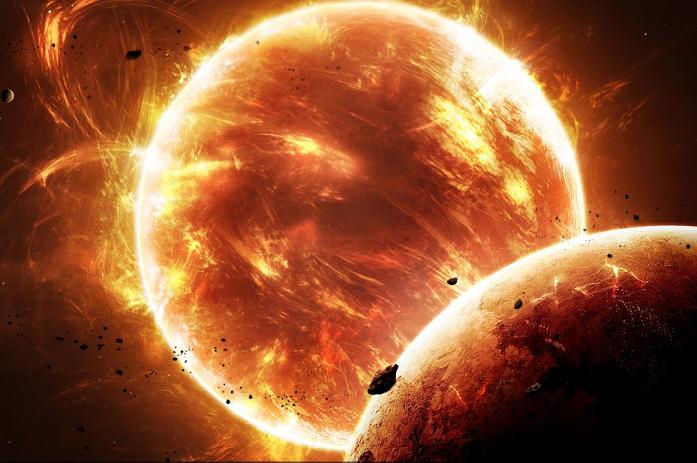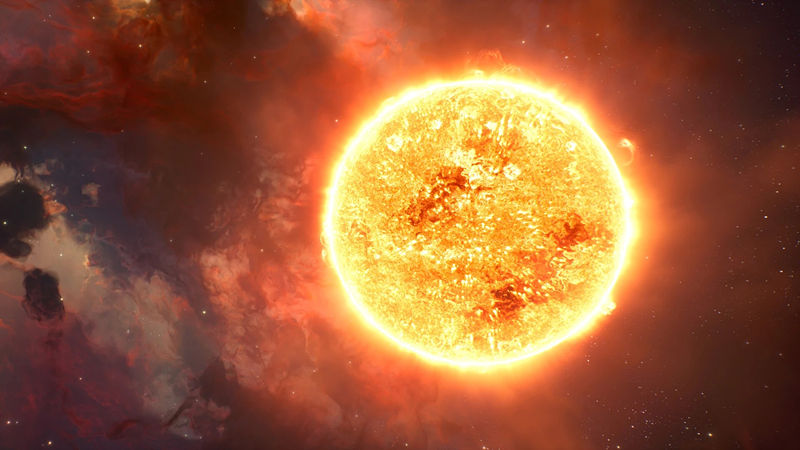In ancient times, when people gazed at the night sky, they discovered that the positions of the vast majority of stars in the sky were unchanging, while only a few stars’ positions were constantly changing. So, people named these unchanging star positions “fixed stars” and the ones with frequently changing positions “planets.”
Now we know that the fixed stars in the sky are actually celestial bodies that, like the Sun, can emit their own light and heat. Besides their ability to emit light and heat, fixed stars are also known for their immense size. Take the Sun, for example. The Sun is just an ordinary yellow dwarf star in the Milky Way galaxy. “Dwarf” indicates its relatively small size. Thus, from the classification of the Sun by scientists, we know that it is not considered large among fixed stars. However, even as a yellow dwarf star, the Sun is incredibly large when compared to the Earth.
The Sun, while being quite large, is still small compared to some of the stars in the universe. There is a red supergiant star located approximately 5,100 light-years away from Earth, and it’s exceptionally massive. It was once believed by scientists to be the largest known star in the universe. That is UY Scuti in the constellation of Scutum, and below, you’ll find ten essential points to know about UY Scuti:
1. UY Scuti
UY Scuti is a red supergiant star with a spectral type of M2-M4Ia-Iab. Despite its enormous volume, its mass is only about 7 to 10 solar masses (approximately 3.3 × 10^6 Earth masses). This star is not only gigantic in terms of size but also extremely bright. Its luminosity is around 3.4 × 10^5 times that of the Sun, making it one of the most luminous stars. UY Scuti is also a semi-regular variable star (SRc) with a pulsation period of approximately 740 days.

The apparent magnitude of this star ranges from +8.29 to +10.56, which means it cannot be seen with the naked eye and requires the use of a telescope for observation. The size of UY Scuti does not determine its classification, as it cannot be categorized as a hypergiant due to its relatively low mass loss rate.
2. Naming
UY Scuti was first discovered by German astronomers at the Bonn Observatory in 1860 and was included in the Bonn Survey (Bonner Durchmusterung) as BD-12°5055. This designation indicates it was the 5055th star in the region between right ascension 0h and declination 12° to 13°. Its variability in brightness was noticed in a later survey, suggesting that it was a new variable star. Following international standards for variable star naming, this star was designated UY Scuti (UY Scuti or UY Sct), signifying that it was the 38th variable star discovered in the constellation Scutum. UY Scuti is located a few degrees north of the A-type star Gamma Scuti (γ Scuti) in the constellation Scutum and is situated to the northeast of the Eagle Nebula.
3. Brightness
UY Scuti is a luminous red supergiant star obscured by dust and categorized as a semi-regular variable with a pulsation period of approximately 740 days. It has a spectral classification of M4Ia. Despite its high luminosity, the light emitted by this star is partially blocked by interstellar dust due to its extreme distance from Earth and its location within the Cygnus Rift. From Earth’s perspective, its apparent magnitude varies between 8.29 and 10.56, which means it cannot be observed with the naked eye and requires the use of a telescope for visibility.

4. UY Scuti vs. Sun
UY Scuti is a red supergiant star located in the southern hemisphere sky in the direction of the Scutum constellation. UY Scuti is estimated to have a diameter approximately 1,700 times that of the Sun, with a surface temperature of 3,400 K and a luminosity 340,000 times that of the Sun. It is situated at a distance of 9,500 light-years from us and appears as a magnitude 9 star. According to stellar theory, UY Scuti likely had an initial mass of about 25 times that of the Sun at its birth, which has since reduced to a current mass of 7 to 10 times that of the Sun due to mass loss. The star’s core is currently undergoing helium fusion, surrounded by a region undergoing hydrogen fusion. Calculations suggest that in the coming millions of years, it will further undergo fusion of carbon, oxygen, neon, and silicon, ultimately resulting in an iron core with no further fusion, leading to a supernova explosion as internal and external forces become unbalanced.
5. Observational Studies
In the summer of 2012, in the Atacama Desert in Chile, astronomers used the Very Large Telescope (VLT) and its Astronomical Multi-BEam Recombiner (AMBER) interferometric instrument to measure the parameters of three red supergiant stars deep within the Milky Way disk (UY Scuti, Antares in Scorpius, and KW Sagittarii). They determined that the diameters of these three stars are over a thousand times larger than that of the Sun, and their luminosities are over 100,000 times that of the Sun. These star sizes were calculated using Roche radii, with a light depth (transparency) of 2/3 and distances taken from earlier publications and relevant academic journals. The study found that UY Scuti is the largest and brightest among the three stars measured, with a radius of 1,708±192 times that of the Sun (i.e., approximately 11.88±1.34 billion kilometers or 7.94±0.89 astronomical units). UY Scuti’s angular diameter is 5.48±0.1 milliarcseconds, and the estimated distance is 2.9±0.317 kiloparsecs (approximately 9,500±1,030 light-years), as initially derived from spectral modeling in 1970. With an effective temperature of 3,365±134 K, the calculated luminosity is 340,000 times that of the Sun, and the initial mass is estimated to be 25 times that of the Sun. If it is a non-rotating star, its mass could be as high as 40 times that of the Sun.

6. Volume
UY Scuti has a radius of 1708 times that of the Sun (1708 R⊙). Its size is so enormous that if you were to place UY Scuti at the center of our solar system, its surface would extend beyond the orbit of Jupiter (with a radius of approximately 5.204267 astronomical units, roughly equivalent to 7.785472 × 10^8 kilometers) and approach the orbit of Saturn (with a radius of about 9.5820172 astronomical units, roughly equivalent to 1.43344937 × 10^9 kilometers). It takes about 6 to 7 hours for light to circumnavigate the star’s equator, while it only takes 14.5 seconds to do so around the Sun. This star has the capacity to hold around 4.5 × 10^9 times the mass of the Sun, which is roughly equivalent to 2 × 10^16 times the mass of Earth.
Until 2012, Canis Majoris VY was considered the largest known star in terms of volume. At that time, Professor Roberta M. Humphreys of the University of Minnesota estimated the radius of Canis Majoris VY to be around 1800 to 2100 times that of the Sun. However, improved measurement methods have led astronomers to discover that its actual radius is much smaller, approximately 1420 ± 120 times that of the Sun.
7. Controversy
As a red supergiant, UY Scuti possesses an extremely large volume, very low density, and a highly unstable state. This star expels a significant amount of material into space at a rapid pace, forming clouds of gas around it. The star is almost entirely obscured by this dust and gas, and due to its low density and high brightness, it loses mass rapidly, similar to most red supergiants. The low transparency of these dust and gas clouds, along with the limitations of modern technology, have made it challenging for astronomers to confirm its size to this day.
8. Evolution
According to stellar evolution models, UY Scuti has begun fusing helium and continues to fuse hydrogen in its shell around the core. Its location deep within the Galactic disk suggests it is a metal-rich star. Stars with initial masses greater than 8 solar masses eventually synthesize heavy elements, with their cores eventually producing iron. This disrupts the balance between gravitational and radiation pressures, leading to core collapse, which may trigger a violent supernova explosion at the end of their lives. Stars like UY Scuti are expected to evolve to higher temperatures, becoming yellow hypergiants, high-luminosity blue variables, or Wolf-Rayet stars, generating intense stellar winds, shedding their outer layers to reveal the core, and eventually exploding as Type IIb, IIn, or Ib/Ic supernovae.

UY Scuti is currently in an extremely unstable phase as a red supergiant. Scientists predict that as a red supergiant, UY Scuti has a lifespan of only around 10 to 50 million years. Afterward, the star will collapse at its core and undergo a supernova explosion, forming a neutron star. The supernova explosion may also pose a threat to planets within the star’s nearby stellar system through the generation of gamma-ray bursts.
9. Demise
Stars with initial masses exceeding 8 solar masses will inevitably undergo a violent supernova explosion at the end of their lives. Currently, UY Scuti is in an extremely unstable phase as a red supergiant, and scientists predict that, within the next several million to tens of millions of years, this colossal entity will ultimately collapse under the force of gravity and transform into a spectacular supernova.
10. Impact of UY Scuti on Earth
Fortunately, UY Scuti is not our close neighbor but rather very distant from Earth. While we may miss out on a bright star, we also avoid a catastrophe. UY Scuti had a mass of 25 times that of the Sun when it initially formed, making it a high-mass star. Such stars have very short lifespans, and their final stages are extremely dramatic.
After UY Scuti exhausts its nuclear fuel, it will undergo a violent explosion, becoming a supernova, with the core collapsing into a black hole. If UY Scuti were just 4.2 light-years away, its supernova explosion would obliterate Earth’s atmosphere (a safe distance should be at least more than 50 light-years), turning Earth into a barren wasteland and wiping out life on our planet. Fortunately, our close neighbors are low to medium-mass stars, allowing life on Earth to continue undisturbed.
END:
In conclusion, based on the ten key points about UY Scuti, we can look forward to its future. As a massive red supergiant star, UY Scuti’s destiny is intertwined with the magnificent process of stellar evolution. Scientists predict that it will undergo a remarkable supernova explosion in the next several million to tens of millions of years, becoming a brilliant star in the cosmos.
This explosion will create new elements in the universe, collapse its core into a black hole, and release tremendous energy. This process will help us gain a deeper understanding of the lifecycle of stars and the synthesis of elements in the universe.
While UY Scuti is extremely distant from Earth, we need not worry about its supernova affecting our existence. However, the future of this star will provide valuable research opportunities for astronomers to unravel the mysteries of stellar evolution and understand significant cosmic events such as supernova explosions and how they shape the universe.
The future of UY Scuti is destined to inspire more scientific research and observations, allowing us to delve deeper into the mysteries of the cosmos while also appreciating the stable and habitable environment within our universe.
More UFOs and mysterious files, please check out our YouTube channel: MysFiles
Lacerta Files: Human beings are the product of genetic engineering by alien civilizations.








